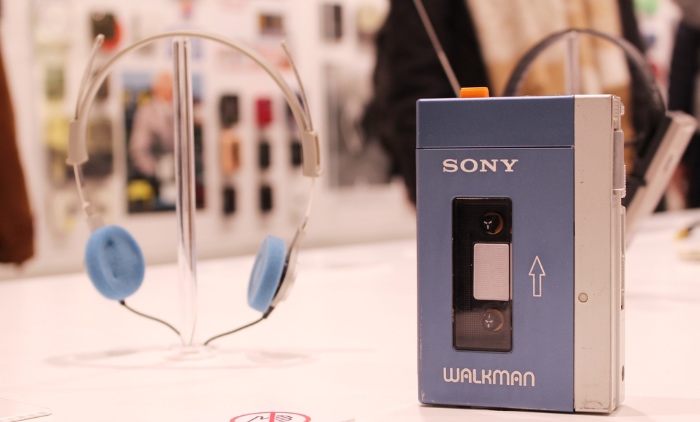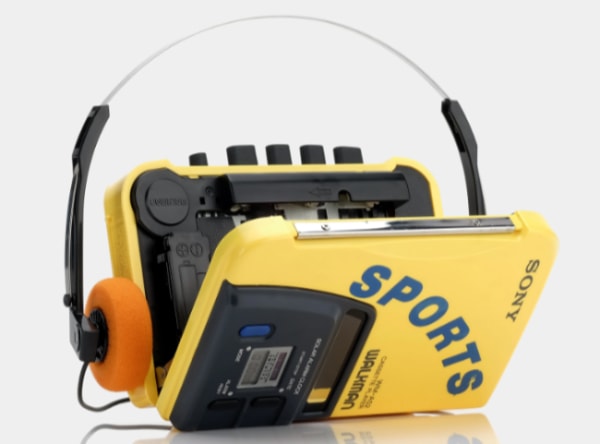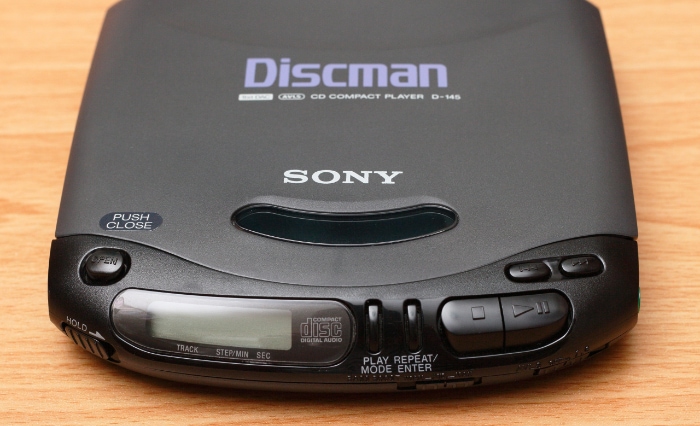Discman vs. Walkman: The Evolution of Portable Music

The realms of portable audio have been revolutionized twice over by two iconic devices: the Walkman and the Discman. These groundbreaking inventions redefined how music was experienced outside the confines of homes and concert halls.
The Sony Walkman, a portable cassette player, burst onto the scene in the late 1970s, turning heads with its compact design and personal listening experience. Not long after, the Discman emerged, elevating the portable audio experience with the clarity and richness of compact discs.
Historical Context of the Walkman
The Sony Walkman, a name synonymous with portable music, marked its entry into the market in 1979. This revolutionary device was not just a piece of technology; it was a cultural phenomenon that altered the way people interacted with music.
Its development was driven by the desire for personal, portable music—a concept almost unheard of at the time. Upon its release, the Walkman was an instant success, appealing to a wide audience with its compact size, affordability, and the novel idea of enjoying music on the go.
Development and Release
The Walkman's journey began with an innovative idea: to create a small, portable cassette player that could play music anywhere. Sony's engineering team worked tirelessly to transform this vision into reality, leading to the creation of a lightweight, user-friendly device with headphones.
Its release broke new ground in the audio world, offering a private listening experience previously confined to stationary record players or large radio systems.
Impact on Society
The Walkman's influence extended beyond technology, permeating various aspects of social life and culture. It became a symbol of personal freedom and individuality, allowing users to curate their own musical experiences in public spaces.
This shift had a profound effect on social behaviors and norms, as people began to embrace a more individualized and mobile lifestyle, thanks in part to the Walkman's ubiquity.
Historical Context of the Discman
Following the trail blazed by the Walkman, Sony introduced the Discman in 1984, heralding the age of portable CD technology. The Discman represented a significant leap in audio quality and functionality, aligning with the growing popularity of CDs over traditional cassette tapes.
Its launch was not just a technological upgrade—it was a step towards a more sophisticated and high-fidelity portable listening experience.
Inception and Market Entry
The birth of the Discman was a response to the rising dominance of CDs, which promised better sound quality and greater durability compared to cassettes. Sony's development of the Discman was a strategic move to capitalize on this shift in consumer preference.
The initial models, while bulkier than their cassette counterparts, offered unprecedented sound clarity and track-skipping capabilities, features that were revolutionary at the time.
Evolution of Portable CD Technology
The Discman played a crucial role in popularizing CDs as the preferred medium for music. Its evolution saw continuous improvements in size, battery efficiency, and anti-skip technologies, addressing the needs of an increasingly mobile and tech-savvy population.
The device's advancement mirrored the broader trends in the consumer electronics industry, which was moving towards more compact, high-performance gadgets. The Discman's journey is a testament to the rapid pace of innovation in portable audio technology, setting the stage for future developments in digital music and media players.
Technological Features and Capabilities of the Walkman
The Sony Walkman, when introduced, was a marvel of portable audio technology. Its design was a radical departure from existing music players, prioritizing portability, simplicity, and personal listening.
The Walkman's success lay in its unique combination of compact design, ease of use, and the novel concept of private music consumption on the go.
Compact Design and Portability
At its core, the Walkman was designed to be lightweight and compact, making it easy to carry. This portability transformed how and where people listened to music, breaking free from the confines of home-based systems.
The use of cassette tapes, which were smaller and more durable than vinyl records, was key to its portability.
Sound Quality and Battery Life
While the Walkman's sound quality was not on par with larger home systems, it was a significant improvement over other portable options available at the time. The device provided a decent audio experience, balancing quality with portability.
Additionally, its battery life was a critical feature, offering extended hours of listening without the need for constant power supply.
User-Friendly Interface
The Walkman's simple interface was another significant aspect. It featured basic controls for play, stop, fast forward, and rewind, making it accessible to a broad user base.
This simplicity was instrumental in its widespread adoption, appealing to users of all ages and technical backgrounds.
Technological Features and Capabilities of the Discman
The introduction of the Sony Discman marked a new era in portable audio, with significant advancements in sound quality and functionality. The shift from cassette tapes to compact discs was a major technological leap, bringing with it improved audio fidelity and new features.
Enhanced Sound Quality
The most notable advantage of the Discman was its superior sound quality. CDs offered a clearer, more dynamic audio experience with a broader range of frequencies than cassettes.
This enhancement was a crucial factor in the Discman's popularity among audiophiles and casual listeners alike.
Advanced Features and Functionality
The Discman introduced several new features that were not possible with cassette-based Walkmans. These included the ability to skip tracks, search within tracks, and later models even offered anti-skip protection to prevent interruptions during movement.
These features significantly improved the user experience, making listening more convenient and enjoyable.
Battery Efficiency and Portability Challenges
While the Discman offered advanced capabilities, it faced challenges in terms of battery efficiency and portability. Early models were bulkier and consumed more power than the Walkman, leading to shorter battery life.
However, subsequent models saw improvements in both areas, as Sony worked to make the Discman as travel-friendly as its predecessor.
Cultural Impact and Popularity of the Walkman

The Walkman did much more than just play music; it transformed the way music was consumed and experienced in everyday life. Its arrival on the market in the late 1970s sparked a significant shift in listening habits and social behaviors, embedding itself deeply into the cultural fabric of the time.
Redefining Music Consumption
The Walkman revolutionized the concept of music consumption. It made music a personal, portable experience, allowing people to listen to their favorite tunes while on the move.
This newfound mobility changed the public's relationship with music, making it a more intimate and individualized experience.
Influence on Social Behavior
The Walkman's impact extended to social behaviors and trends. It became a symbol of the modern, on-the-go lifestyle, appealing to a young, active demographic.
The device also introduced the notion of isolating oneself from the surrounding environment with headphones, a practice that has become commonplace in contemporary society.
Walkman as a Cultural Icon
The Walkman quickly became a cultural icon, representing freedom, individuality, and the technological zeitgeist of the era. It featured prominently in media, movies, and advertising, becoming a must-have accessory for the youth of the time.
Its influence was so profound that it is often credited with shaping the cultural landscape of the 1980s.
Cultural Impact and Popularity of the Discman
Following in the footsteps of the Walkman, the Discman also made a significant cultural impact, albeit in a different technological era. It arrived during a time of rapid digital advancement and played a key role in transitioning the world into the digital age of music.
Advancing Digital Music Consumption
The Discman was instrumental in popularizing CDs, which represented the next step in the evolution of digital music. Its ability to play CDs marked a shift towards higher quality, more durable media formats, influencing both the music industry and consumer preferences.
Impact on the Music Industry
The introduction of the Discman coincided with and contributed to the rise of the CD market. This shift had a substantial impact on the music industry, affecting everything from album production to sales strategies. The Discman helped establish CDs as the dominant format for music distribution throughout the 1990s.
Discman in the Digital Era
As the world moved towards digital technology, the Discman became a bridge between the analog past and the digital future. It was a precursor to the MP3 players and streaming services that would follow, playing a crucial role in shaping modern digital music consumption habits.
The device's popularity underscored the public's readiness for higher-quality, more advanced portable listening options, setting the stage for the next generation of personal audio devices.
User Experience and Design of the Walkman
The Sony Walkman not only stood out for its technological innovation but also for its user-centric design and experience. Its design philosophy centered around functionality and user comfort, aspects that were pivotal in its widespread adoption and enduring popularity.
Ergonomic and Portable Design
The Walkman’s design was a testament to Sony’s focus on portability and ease of use. Its compact, lightweight structure made it convenient for users to carry music with them.
This portability was enhanced by its simple and robust design, which was capable of withstanding the rigors of everyday use.
User Interface and Accessibility
The Walkman's interface was straightforward, making it accessible to a wide range of users. Basic controls for play, stop, fast forward, and rewind were intuitively placed, and the device required minimal setup.
This simplicity in design and operation was key to its appeal across various demographics.
Impact on Lifestyle and Fashion
The Walkman's design also had an impact on lifestyle and fashion. It became more than a music player; it was a fashion statement and a symbol of modernity.
Its sleek design and the iconic image of headphones around the neck or ears became synonymous with a contemporary, dynamic lifestyle.
User Experience and Design of the Discman

The Discman, while following the Walkman’s footsteps in portability and personal audio, brought its own set of design innovations and user experience enhancements. Its design was a response to the evolving needs and expectations of a digitally inclined audience.
Advances in Design for Enhanced Sound Quality
The Discman was designed with a focus on sound quality. The use of CDs allowed for better audio fidelity, and the device was engineered to maximize this potential.
Though initially bulkier than the Walkman, the Discman's design evolved to become more compact and user-friendly.
Interface and Functionality
The Discman featured a more advanced interface than the Walkman, with additional functions like track skipping, search, and later models even incorporated anti-skip technology. These features significantly improved the listening experience, offering users more control over their music.
Challenges in Portability and Durability
Despite its advancements, the Discman faced challenges in terms of portability and durability compared to the Walkman. Early models were less robust and more prone to skipping when moved.
However, as technology progressed, these issues were largely addressed, resulting in a more reliable and travel-friendly device.
Legacy and Modern Relevance of the Walkman
The Sony Walkman transcends its role as a mere gadget, securing a lasting legacy in the annals of consumer electronics and popular culture. Its impact extends well beyond its years of peak popularity, influencing not only the development of portable audio devices but also shaping user interaction with music and technology.
Lasting Impact on Personal Audio Technology
The Walkman's introduction of portable, personal audio created a paradigm shift, setting a standard for future devices. It paved the way for the development of portable CD players, MP3 players, and eventually, digital music streaming on mobile devices.
The concept of personal, portable music that the Walkman popularized is now a fundamental aspect of modern music consumption.
Walkman in Contemporary Culture
Despite the technological advancements that have rendered the original Walkman obsolete, it continues to hold a place in contemporary culture. Its iconic status is celebrated in various forms, from its representation in media and entertainment to its presence in vintage and collector markets.
The Walkman remains a symbol of innovation and a nostalgic reminder of the era it defined.
Legacy and Modern Relevance of the Discman
The Discman, while following a different trajectory from the Walkman, also left an indelible mark on the world of personal audio. Its role in the transition from analog to digital music formats was crucial and set the stage for the next wave of technological advancements in the audio realm.
Pioneering the Digital Audio Revolution
The Discman was at the forefront of the digital audio revolution. By popularizing CDs, it played a vital role in shifting the industry towards digital formats.
This shift had far-reaching implications, influencing everything from music production and distribution to consumer listening habits.
Discman's Influence on Future Technologies
The technological innovations introduced by the Discman laid the groundwork for subsequent developments in portable music players. Its emphasis on improved sound quality and advanced features influenced the design and functionality of MP3 players and, later, smartphones with music-playing capabilities.
The legacy of the Discman is evident in the premium placed on sound quality and compact design in today's audio devices.
Advancements and Limitations of the Walkman
The Sony Walkman, a trailblazer in portable audio, brought numerous advancements to the realm of personal music consumption. However, like any pioneering technology, it also had its limitations, which became more apparent as technology progressed.
Technological Advancements
The Walkman's greatest advancement was in making music portable and personal. Its compact design, use of cassette tapes, and inclusion of lightweight headphones were significant innovations at the time.
The Walkman also introduced a new way of experiencing music privately, a concept that has since become a standard in our daily lives.
Limitations
Despite its revolutionary impact, the Walkman had limitations. The audio quality was inferior to stationary music systems, and the reliance on cassette tapes meant limited sound fidelity and susceptibility to wear and tear.
Additionally, the Walkman's mechanical nature made it prone to issues like tape jams and degraded audio quality over time.
Advancements and Limitations of the Discman

The Discman represented a significant leap forward in portable audio technology, introducing the clarity and precision of digital sound. However, it too had its share of limitations, which influenced its place in the rapidly evolving landscape of personal audio devices.
Technological Advancements
The most notable advancement of the Discman was the utilization of CD technology, offering a significant improvement in sound quality over cassette tapes. Features like track skipping, digital anti-skip protection, and enhanced sound customization options marked major enhancements in user experience. The Discman played a key role in transitioning consumers from analog to digital audio formats.
Limitations
The Discman's early models were bulkier and less robust compared to the Walkman, making portability a challenge. Battery life was another issue, as playing CDs required more power.
Moreover, the CD format, while offering better sound quality, was more susceptible to damage and skipping, particularly in portable scenarios.
Conclusion
Reflecting on the journeys of the Walkman and Discman, it's clear that these devices were much more than mere music players; they were harbingers of a new era in personal audio and cultural symbols of their respective times. The Walkman's introduction of portable, personal listening laid the groundwork for a revolution in music consumption, changing not only how people listened to music but also their interaction with technology and society.
The Discman furthered this legacy, propelling the world into the digital age with improved sound quality and advanced functionalities.
Both devices faced their own set of challenges and limitations, a natural aspect of pioneering technology. The Walkman's reliance on cassette tapes and the Discman's initial struggles with portability and battery life were significant hurdles, yet they also highlighted the rapid pace of innovation in consumer electronics.
These challenges were instrumental in shaping future developments in the field of portable audio.
Today, as we look back at the Walkman and Discman, their influence is undeniable. They not only served as stepping stones to modern digital music players and streaming services but also left an enduring impact on the cultural and technological landscape.
Their legacy is a testament to the power of innovation and the ever-evolving nature of how we experience music. As technology continues to advance, the Walkman and Discman remain iconic reminders of a time when music first stepped out of the living room and into the rhythm of everyday life.
Table of Contents
- Historical Context of the Walkman
- Historical Context of the Discman
- Technological Features and Capabilities of the Walkman
- Technological Features and Capabilities of the Discman
- Cultural Impact and Popularity of the Walkman
- Cultural Impact and Popularity of the Discman
- User Experience and Design of the Walkman
- User Experience and Design of the Discman
- Legacy and Modern Relevance of the Walkman
- Legacy and Modern Relevance of the Discman
- Advancements and Limitations of the Walkman
- Advancements and Limitations of the Discman
- Conclusion


